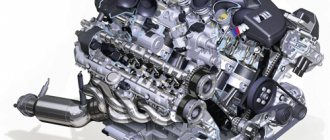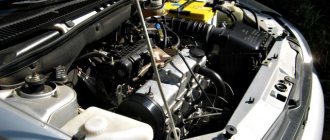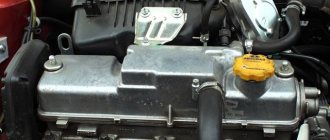Many owners of the domestic Lada Priora car are extremely concerned about the issue of valve bending. The upcoming publication is intended to dispel doubts. Also, from the information offered, you can glean very useful information about the technical characteristics and main problems of the engines that manufacturers equip these machines with.
Motor 126 and 127: working life, differences
These engines on Priora had a displacement of 1.6 liters (or 1596 cm3). Optimal for city sedans, the engine size of the Lada Priora gave a good combination of dynamics and consumption: along with very decent acceleration, fuel consumption does not exceed sky-high numbers. Both engines received good marks, because the car behaved perfectly in the city and on the highway.
127 motor - looks like this
In fact, the 126 Priora engine became the first sixteen-valve engine for this model, and the 127 is a modified version, “overclocked” by AvtoVAZ designers. In addition to the same engine displacement, they have other identical characteristics. The in-line type of arrangement of four cylinders provides a simplified design that can be repaired on your own.
The distributed multipoint injection system is involved in creating a good, rich fuel-air mixture (a lean mixture can lead to breakdowns). The cylinder diameter is 82 mm, the piston stroke is 75.6 mm, the compression ratio is 11. The “engines” fall under the Euro 4 standard, they are powered by gasoline with an octane rating of 95.
The 126 engine for the Priora received the following characteristics: 98 hp. (72 kW at 5600 rpm), acceleration to 100 km/h in 11.5 seconds (with manual transmission), city consumption 9.1 l - 100 km (manual transmission), maximum torque - 145 Nm.
The 127 engine for the Priora was upgraded to the following figures: 106 hp. (78 kW at 5800 rpm), acceleration to 100 km/h in 11.5 seconds (with manual transmission), city consumption 8.9 liters per 100 km (with manual transmission), maximum torque – 148 Nm.
The difference may not seem so noticeable, but this is a very small but strong step in design on the part of AvtoVAZ (this is where the change to sixteen-valve “engines” with a volume of 1.6 liters ended). For a car of the Lada Priora class, the engine power was sufficient.
In the same block it is necessary to say about the operating temperature. An absolutely normal operating temperature is considered to be between 90 and 95 degrees Celsius. Further, when the car is being pushed in a traffic jam, is basking in the sun, or for some other reason, but can still work - from 97 to 110 degrees. The engine is slow in places and wears out a lot, but you can still get to your destination. A temperature below 90 degrees is a direct sign indicating that the car has not yet warmed up, and it is better to wait in place until the arrow points to the coveted 80-90 mark.
Operating a car at temperatures above 110 degrees is dangerous because the service life of the engine is noticeably reduced - hot parts undergo very severe wear, overcoming the force of friction.
In general, the service life of the Lada Priora engine with a normal driving style and careful treatment is 200,000 km - after this mark the time comes when the “engine” requires major repairs. AvtoVAZ mentioned the timing belt separately as a recommendation, saying that it needs to be checked every 100,000 km (many car enthusiasts talk about the figure of 50,000 km).
All Lada engines have a problem, and it is related to the valves, which will be discussed further.
Recommendations for improvement
For the first time, they decided to increase the power of the new Priora 21126 engine at the factory in order to create a sports modification of it. Camshafts with increased lift, a lightweight connecting rod and piston group were installed, and the intake and exhaust tracts were modified. This is how the first domestic sports unit appeared, which was put into production, and they began to install it on the Lada Granta Sport model.
The technical characteristics of the engine are as follows: engine power from the Priora has increased to 118 hp. torque - up to 154 Nm at 4700 rpm, fuel consumption also increased to 7.8 liters per 100 km with a combined driving cycle. We will give a number of recommendations on how to independently increase the power of Priora engines:
- The simplest and most affordable way is to install a zero-resistance exhaust tract. The essence of its work is to reduce the resistance of the path, as a result of which some of the power spent on overcoming this resistance will be released and become useful.
- The same operating principle applies to the zero-resistance intake tract. Installing the receiver and throttle valve to 56 mm will allow the power unit to “breathe” more freely, and your Lada Priora will become several horsepower more powerful.
- Deeper tuning - new camshafts with a sports configuration, allowing the intake and exhaust valves to open more. This will give a noticeable increase in the agility of the car, especially in city conditions.
- Replacing the standard valves and connecting rod-piston group with a lightweight one will again release some of the useful energy of the unit and add it to the main power. Here you can kill two birds with one stone: install pistons with recesses, thereby eliminating the possibility of them “meeting” with the valves when the timing belt breaks.
- We should not forget about CHIP tuning. After major changes in the engine configuration, its operating mode will definitely improve, and in order to optimize it and adjust fuel consumption, you need to do a flashing.
Recommendations are given taking into account that the power plant is in good technical condition. If this is not the case, when tuning it is worth replacing worn parts and oil in order to get the desired effect from the changes. As a result of the above measures, the Lada Priora will receive an additional 20-30 hp. without reducing the resource.
How many horses can Priora have in addition to this? Quite a lot, there are capabilities and components to increase the power ultimately to 400 hp. This is due to a radical modification of the power plant: boring the cylinders, grinding the cylinder head, replacing the injectors and fuel pump with more efficient ones, installing four throttle valves and a turbocharger.
We should not forget about modernizing the brake system. Such tuning will give excellent results in terms of power, but the engine life will be significantly reduced, and fuel consumption, on the contrary, will increase significantly.
Sores
Of course, Priora has sores, which you just need to be attentive to and always have a certain amount of rubles in case of “exacerbation”.
- The most common is rust . More often, wheel arches, fender liner attachment points, and the bottom of doors (hidden cavities) are subject to corrosion. Rust appears on the roof, closer to the windshield, and on the hood, near the washer nozzles. To prevent rust from spreading throughout the car, treat the stains with anti-corrosion mastic.
- Over time, the gearbox to crunch when changing gears . The reason is weak synchronizers. The crunching often disappears as suddenly as it appeared, but it is better to contact a car mechanic. Due to the unreliability of the box, the shaft may burst, causing the gearbox to simply break. Repair and a new box will cost 40-50 thousand rubles. Some car owners, to prevent the problem from recurring, install boxes from other VAZ models, for example, VAZ-2115.
- Priora's problem number three is the immobilizer . Over time, it stops working completely, because... What comes from the factory is simply cheap, Chinese. The owners repair it or solder it, do chip tuning. The asking price is 2-3 thousand rubles. If the Priora you are interested in has not yet encountered this problem, get ready.
- 8 out of 10 Prior owners have already changed brake hoses, clutch and heating system hoses . Keep these elements under control, otherwise serious repairs will not be avoided. The asking price is 5-6 thousand rubles.
- is often covered . Moreover, in which mode it breaks down, in this mode the headlights continue to burn. Those. if you were driving on the highway with high beams and the unit breaks, the light will remain on even when you turn off the car. Fortunately, you can change it easily and quickly, even with skillful hands you can do it yourself. The cost of the element is 1-1.5 thousand rubles.
- Another problem that “pops up” in 9 out of 10 Priors is the “guzzling” of oil . When it appears depends on operating conditions and mileage. Moreover, the spark plugs and exhaust pipe will remain clean and there will be no leaks. Experienced car owners advise that if there is a fantastic loss of oil, go to a mechanic as soon as possible. Most likely, you will have to repair the cylinder head, which will cost 20-30 thousand rubles.
The set of problems is quite large, and many are expensive to eliminate. But keep in mind: similar procedures with a more or less budget foreign car would cost 1.5-2 times more.
Engine test tables and graphs
As you can see from the table, the power of the 1.8-liter engine has a positive effect on its dynamics and even consumption. It would seem that it is fuel consumption that should increase, but test results prove the opposite.
Engine power
In this graph, the favorite is immediately visible; there are practically no equal to the 1.8-liter engine.
General characteristics
Initially, the car was equipped with an 8-valve engine from the VAZ 2114, about which car enthusiasts in practice know all the characteristics, in particular, what kind of service life it has in different modes. Therefore, the first “Priors” did not receive rave reviews from customers.
Subsequently, the car was equipped with its own 16-valve unit modification 21126 with a displacement of 1.6 liters and a power of 98 horsepower, which made the VAZ 2170 truly competitive. Dynamic performance has been improved, emissions into the environment and fuel consumption have been reduced. Relatively recently, an updated version of the 21127 engine with a power of 106 hp appeared. which has been installed on Priora since 2013. Comparative characteristics of all three units are given in Table 1.
Table 1
| Specifications | Engine VAZ 2114 | Engine VAZ 21126 | Engine VAZ 21127 |
| Year of issue | 1994 | 2007 | 2013 |
| Cylinder block material | Cast iron | Cast iron | Cast iron |
| Type/number of cylinders | Inline/4 | Inline/4 | Inline/4 |
| Number of valves | 8 | 16 | 16 |
| Piston stroke, mm | 71 | 75,6 | 75,6 |
| Cylinder diameter, mm | 82 | 82 | 82 |
| Compression ratio | 9,8 | 11 | 11 |
| Working volume, cm³ | 1499 | 1597 | 1596 |
| Unit power, hp | 78 at 5400 rpm | 98 at 5600 rpm | 106 at 5800 rpm |
| Torque, Nm | 116 at 3000 rpm | 145 at 4000 rpm | 148 at 4000 rpm |
| Fuel consumption highway/city/mixed, l/100 km | 5,7/8,8/7,3 | 5,4/9,8/7,2 | Mixed – 7 |
Two trump cards of VAZ engines
1. Cheap repairs. It is due to several factors:
- The design of the engine is familiar to almost any master.
- The tools and equipment needed for repairs are always available.
- Relatively inexpensive spare parts.
2. You can buy a new VAZ engine for a relatively small amount. An eight-valve engine will cost 40,000–50,000 rubles, and a sixteen-valve engine will cost up to 70,000 rubles. At the same time, for example, the most affordable Renault K4M engine, which is installed on the Logan, and earlier on the Lada Largus, will cost at least 104,000 rubles.
Updates and shortcomings
The table clearly shows how many horses the Priora had with the old power plant and how the power and torque changed as the update progressed. Here is a description of how the design features of the new units changed compared to the old ones:
- The number of valves has increased, there are 4 of them for each cylinder. It's no secret what a positive impact this factor has on engine performance. The filling of the cylinder with the combustible mixture improves, the chamber is qualitatively emptied of combustion products (exhaust gases), the operation of the unit becomes more stable, power increases while fuel consumption decreases.
- The compression ratio is increased by increasing the piston stroke. The new engine 21126 and 21127 now uses gasoline with a higher octane number, but at the same time the efficiency of fuel combustion increases, which has a positive effect on power. It’s impossible not to notice how the working volume of the Priora’s engine has increased thanks to the increased piston stroke.
- In modification 21127, compared to 21126, the intake manifold was modified. How this affected the engine performance of the Priora can be seen in the table. Power increased by 8 hp. in addition, performance at low and medium speeds has improved.
- The new engines on the Priora have better environmental performance and lower fuel consumption. This was achieved through such improvements as modernizing the crankcase ventilation system and reducing the weight of the piston group. Now crankcase gases are burned more intensively in the cylinders and the emission of harmful substances into the atmosphere has decreased.
- Over the many years of operation of VAZ vehicles, a definite opinion has developed that the power units of Zhiguli cars do not last 150 thousand km until they are overhauled. Now, due to the use of new, higher quality components, the engine life has increased to at least 200 thousand km.
Despite the fact that the updated Priora engine is almost the most advanced domestic unit, it has its drawbacks. For example, when a timing belt breaks, the valves inevitably collide with the pistons and bend - this is its most serious drawback. How to eliminate it without waiting for trouble? It is necessary to replace the standard pistons with new ones, with special selections for the valves.
The remaining shortcomings are not so significant and they are usually associated with some kind of defect that can still be found on domestic cars. This could be increased noise from the operation of hydraulic compensators (often found on VAZ cars), an unexpectedly burnt gasket under the cylinder head, or floating idle speed. Or some unit of the attached equipment fails:
- a drop in fuel pressure in the system leads to difficulty starting the Priora engine and loss of its power;
- sensor malfunctions;
- air leaks in the fuel tract through the pipes;
- problems with the injector throttle valve.
Updated power plants
At the very beginning, this car was heavily criticized, especially for the old “ten” 8-valve engine. However, very soon they began to install a new engine with 16 valves on the car, which amazed the new owners with its qualities. If you look at its technical characteristics, you won’t notice much difference with the old motor. Yes, fuel consumption was reduced by about 1 liter and by 10 liters. With. The power increased, but this did not have much effect on the dynamics. The maximum speed, although increased, was only 20 km/h. The most important thing is that the engine runs much quieter. This is immediately felt by both the driver and passengers - associations arise with high-quality modern foreign cars. Therefore, how many horses Priora has is not a fundamental question.
The second very important point is that the engine operates smoothly throughout the entire speed segment. If the “ten” required some getting used to from the driver, for example, he had to constantly glance at the tachometer and listen to the engine, then the “Lada Priora” allows you to drive without the slightest stress. It was possible to improve the engine performance of the Priora not only through a new gas distribution system, but also through the use of updated pistons, connecting rods and a number of other parts.
In addition to the basic 16-valve engine, other engines are also installed on the Priora. In particular, there is a version of the VAZ-21127, which features a modified intake manifold. How many more “horses” did this add? Only about 8, the total engine power of the model was 106 hp. With. Also among the Priora engines there is a version of the VAZ-21128, which is manufactured by one of the tuning companies. Its power has been increased to 120 hp. With. In general, the units are almost identical to each other both in design and in service life. Therefore, their reliability is approximately the same.
But the build quality of the motors is very different. Moreover, the power plant itself is usually assembled quite well, but the attachments are rather weak. Almost everyone knows what problem areas the engine has. For example, a pump often fails. Early models of the car had problems with the timing pulley until it was replaced with a Gates branded one. Despite the presence of shortcomings, the car does not cause much trouble.
How much does engine 126 and 127 cost?
Engine 126 has catalog number 21126100026030, sells for about 107,000 rubles, engine 127, respectively, has catalog number 21127100026030, its price is slightly higher by 3-5 thousand rubles. The price on the secondary market will be significantly lower (up to 20-25 thousand rubles), but the savings will not pay off - a used “engine” can last no more than 1000 km, this is a real lottery.
How to find out what engine is in a Priora
You can find out by looking at the plate on the left glass of the rack, where the engine number is written on the edge. From it you can understand the 8-valve unit, or 16. You can also recognize the modification 21126 or 21127.
Electrics
Be prepared for the fact that you will have to frequently change the headlight and low beam bulbs. The windshield wiper switch will malfunction and the windows will not go up.
The factory alarm often malfunctions: it goes off falsely, refuses to close or open doors. The problem can only be corrected by installing a new system. The price of such pleasure is 10-30 thousand rubles (if with auto start, then more expensive).
The electric power steering often malfunctions - it turns hard, the steering wheel has to be pushed, or it jerks on its own. Usually the previous owner will fix this problem under warranty. If he didn’t do this, get ready to pay at least 10-15 thousand rubles to car mechanics. Or try cleaning the contacts or changing the speed sensor.
The heating system may also fail if this has not happened before. The price of spare parts is from 1 to 1.5 thousand, repairs are another 1000 rubles.
Signs of the need for internal combustion engine repair
The reasons why the operation of the engine is disrupted are arranged in a small list, starting with refusal to start and ending with floating idle speed (this problem was removed on the 127 “engine”). Not all breakdowns end in capital damage - sometimes it’s enough to add oil, sometimes it’s enough to adjust the ECU settings.
Compression reduction
A decrease in cylinder compression below 16 atmospheres is a bad sign. Such a high limit corresponds to a compression ratio of 11.
If the compression decreases (or vice versa increases), then the “engine” will have to be rebuilt.
Knocks in the engine
Engine knocks can come from several points. These could be hydraulic compressors, timing belt rollers or pins. The knocking noise could also be caused by low oil level. The answer to the question will be given by a thorough detailed inspection of all parts of the unit and checking the oil level.
Blue smoke from the exhaust pipe
The blue smoke that comes from the exhaust pipe appears when oil enters the combustion chamber. It can leak either from the valves or from under the piston. The result is the same: the oil is eaten up and blue smoke pours out of the chimney. Once the leak is located, half the problem will already be solved.
Troit motor
Sometimes in the cold the engine may stall - don’t be alarmed by this, because it may simply be one of the spark plugs that fails. In this case, we advise you to simply restart the engine and it will stop running.
Engine
Lada Priora has undergone changes several times, both externally and technically. The appearance, power plant and transmission changed.
Below is an example of engines that were installed on the VAZ 2170-72.
Engine 21116 (8 valves)
This engine was installed on the VAZ 2114 and Lada Kalina, and was later inherited by the Priora. The power of this internal combustion engine is 80 hp. with a volume of 1.6 liters, which is very small. Such an engine does not have good dynamics, and it is difficult for it to “drag” the body of the Priora.
Pros:
- Does not bend valves;
- Easy to maintain;
- Cheaper spare parts;
Minuses:
- Low power;
- Noisiness;
The installation of such an engine continued until 2022.
Engine 21126 (16 valves)
16 valve engine with more power and torque compared to 116. It is a modified model of the 124 engine. Its power is 98 hp. with a volume of 1.6 liters.
Pros:
- Great power;
- No noisy operation;
Minuses:
- Bend valves when the belt breaks;
- Expensive spare parts;
Engine 21127 (16 valves)
The modified 126 engine received the index 21127; the intake in this engine was changed, thereby increasing the power to 106 hp. with the same volume of 1.6 liters. They began to install a new cable gearbox for this engine.
Pros:
- High power;
- No noisy operation;
Minuses:
- Bend valves;
- Expensive spare parts;
Engine 21128 (16 valves)
This engine was specially designed for more powerful Lada cars with the “Super Auto” nameplate. The power of this engine has increased, as has its volume. The number of horsepower in the super car engine increased to 123, and the volume to 1.8 liters, which radically affected the dynamics of the car.
Pros:
- Good dynamics and high power;
Minuses:
- Bend valves;
- More expensive spare parts;
Expert commentary
Victor Lelikov,
employee :
Spare parts for VAZ engines are in good demand. This is why there is such a high proportion of substandard spare parts on sale. Such parts come from three sources. The first is cooperative spare parts: their use is especially dangerous. For example, the service life of timing belts can be only a few tens of engine hours. The second source is still encountered defects from the official supplier. This is a spare part that did not pass VAZ technical control, but went on sale. Such parts and components destroy buyers’ faith in the reliability of VAZ cars. Finally, the third source is remanufactured engine parts. But these are becoming less and less common.
Where is the engine identification number on the Priora?
The engine code is found using these three means:
- lighting device;
- car passport;
- vehicle operating instructions.
The Vin code of a car from the VAZ manufacturer can be located in several standard places, regardless of the modification of the car or the number of valves:
- on the cylinder on both sides or on one;
- near the hole where the amount of engine lubrication is checked;
- where the engine is connected to the automatic or manual transmission;
- at the base of the corrector.
Sometimes the motor coding may be located in a different place. But this rarely happens.
Engine number on 16 valve
The engine number of 16 valves on a Priora can be viewed by first removing the air filter housing. Disconnect the corrugation. Using a mirror, the car owner will see two rows of numbers. Since the coding is located on the cylinder block below the thermostat housing.
To read the numbers and compare with the documentation, you will need to use a rag and WD 40 to clean the metal. The numbers tend to get dirty with dust.
Engine number on 8 mi valve
On an eight-valve Lada Priora engine, the engine coding is in the same place as on a 16-valve engine. The numbers are located on the end of the cylinder block, above the clutch housing. But there are also exceptions.
For example, on new models, the manufacturer may change the location of the motor code. In this case, he usually indicates the location of the VIN code in the technical passport for the car.
Lada Priora is the most stolen car among other domestic vehicles. Therefore, a car owner should always have an idea where the engine coding is located in order to refuse to buy a stolen car. Therefore, next we will talk about exceptions to the location of plates with vehicle data.
Powertrain Maintenance
The frequency of maintenance of the Priora engine by the manufacturer is 15 thousand km. It is recommended to carry out the first maintenance after 3 thousand km. The main attention should be paid to checking all attachment points for attachments. During this same service, the first oil and oil filter change is carried out. If the engine is 8-valve, it is worth checking the valve clearances. For a 16-valve engine, this measure is not necessary, since hydraulic compensators are installed on this power unit. Similar work is carried out after 15 thousand kilometers of the Priora.
After the odometer reaches a value of 30 thousand km, in addition to changing the oil and oil filter, the spark plugs and power system filters require replacement. Often, at this mileage value, the timing tension pulley gradually begins to fail. If the Priora has an 8-valve engine, it will not be superfluous to replace the valve cover gasket.
Design Features
All internal combustion engines on Priora operate at a temperature of 95 degrees. They are able to withstand such high degrees thanks to a special alloy of the cylinder head, which does not deform when heated to high temperatures.
However, if it’s hot outside, the engine quickly heats up and in traffic jams it starts to push and stall. Operating a power device at temperatures above 110 degrees is dangerous for it. The lifespan is reduced, rubbing parts wear out quickly.
Crank mechanism
The engine pistons are made of an alloy of aluminum and silicon. This ensures their high wear resistance and temperature resistance. The head of each piston is cylindrical with a flat bottom. The skirt is oval in cross section and barrel-shaped in longitudinal section.
To improve and speed up the running-in of the mechanism, the entire surface of the piston is coated with tin. And compression rings are cast from cast iron. The outer surface of the upper ring, which is adjacent to the cylinder, is coated with chrome plating. This increases the lifespan of the ring.
The height of the compression rings is 2 mm, and the height of the oil scraper ring is 4.9 mm. The piston pins are made of low alloy steel. They are selected for the pistons with minimal clearance. This is necessary to prevent your fingers from knocking while working.
timing belt
The timing belt of the Priora car is made of a durable belt. Many car owners say that it is the gas distribution mechanism that is the problem with Priora engines. At 100 thousand kilometers you may find cracks on the timing belt or light chips in the rubber. This means that he is living his last kilometers. When replacing a belt, it is best to change the entire gas distribution mechanism. Namely, sprockets, a crankshaft toothed pulley with a washer, sometimes replace the generator belt.
The belts that are installed in engines on Lada Priora have 137 teeth. If one wears out, slippage begins, and sometimes the belt can hit the valves. As a result of the break, it hits the valves with 100% accuracy and bends them.
Therefore, experienced mechanics recommend putting the car in for preventive maintenance every 12 months or 100,000 kilometers. Thus, the car owner will avoid major engine repairs or complete replacement.
Systems
The closed liquid cooling system on the Priora allows the engine to cool better on hot days or when idling in traffic jams. It effectively removes heat and prevents the Priora from overheating even at temperatures of plus fifty Celsius.
The power supply system on the car is injection. Carburetor systems are already a thing of the past. Now the fuel is injected into the combustion chamber at a certain angle, oil and air are supplied and then everything is mixed. Such innovations ensured stable operation of the motor.
Similar article Technical characteristics and maintenance of the 603 Mercedes engine
The upgraded crankcase ventilation system does not allow large amounts of exhaust gases to be released into the atmosphere. The reduction and modernization of the connecting rod and piston group reduced the amount of gasoline consumed by the Priora engine.
Let's look at the list of cars on which these engines were installed.
Regular diagnostics are the key to long engine operation
In addition to all of the above, regular diagnostics also help to increase the service life of the motor. The engine on a Priora can experience enormous loads if any of the systems are not working correctly. For example, if fuel equipment breaks down or there are malfunctions in the ignition system, the cylinders may periodically turn off, which will negatively affect the durability of the piston group. Failure of sensors also leads to certain problems in the engine operating mode. By identifying a diagnostic failure in time and promptly eliminating it, the motor can be returned to normal and the negative impact of the breakdown can be reduced.
If you regularly inspect the Priora engine, it is quite possible to prevent many serious problems. It is worth remembering that repairing fuel equipment or ignition is much easier than doing a major overhaul of the engine. Plus, interfering directly with the engine itself usually reduces its resource. If the old Zhiguli models were assembled by hand, the Lada Priora is made mainly by robots, so when repairing the engine, the factory precision of the assembly can be disrupted. Because of this, backlash may begin to form in the parts, as a result of which they will begin to wear out faster. And how much horsepower can you lose if you do a major overhaul! In short, it’s better not to get into the engine.
Source
Recommendations for improvement
For the first time, it was decided to increase the power of the new Priora 21126 engine at the factory in order to create a sports modification of it. Camshafts with increased lift, a lightweight connecting rod and piston group were installed, and the intake and exhaust tracts were modified. This is how the first domestic sports unit appeared, which was put into production, and they began to install it on the Lada Granta Sport model.
The technical characteristics of the engine are as follows: engine power from the Priora has increased to 118 hp. torque - up to 154 Nm at 4700 rpm, fuel consumption also increased to 7.8 liters per 100 km with a combined driving cycle. We will give a number of recommendations on how to independently increase the power of Priora engines:
- The simplest and most affordable way is to install a zero-resistance exhaust tract. The essence of its work is to reduce the resistance of the path, as a result of which some of the power spent on overcoming this resistance will be released and become useful.
- The same operating principle applies to the zero-resistance intake tract. Installing the receiver and throttle body to 56 mm will allow the power unit to “breathe” more freely, and your Lada Priora will become several horsepower more powerful.
- Deeper tuning - new camshafts with a sports configuration, allowing the intake and exhaust valves to open more. This will give a noticeable increase in the agility of the car, especially in city conditions.
- Replacing the standard valves and connecting rod-piston group with a lightweight one will again release some of the useful energy of the unit and add it to the main power. Here you can kill two birds with one stone: install pistons with recesses, thereby eliminating the possibility of them “meeting” with the valves when the timing belt breaks.
- We should not forget about CHIP tuning. After major changes in the engine configuration, its operating mode will definitely improve, and in order to optimize it and adjust fuel consumption, you need to do a flashing.
Recommendations are given taking into account that the power plant is in good technical condition. If this is not the case, when tuning it is worth replacing worn parts and oil in order to get the desired effect from the changes. As a result of the above measures, the Lada Priora will receive an additional 20-30 hp. without reducing the resource.
How many horses can Priora have in addition to this? Quite a lot, there are capabilities and components to increase the power ultimately to 400 hp. This is due to a radical modification of the power plant: boring the cylinders, grinding the cylinder head, replacing the injectors and fuel pump with more efficient ones, installing four throttle valves and a turbocharger.
We should not forget about modernizing the brake system. Such tuning will give excellent results in terms of power, but the engine life will be significantly reduced, and fuel consumption, on the contrary, will increase significantly.
Rules for long-term use
Surely every Priora owner wants to operate his car without unnecessary unexpected costs and is thinking about how to increase the car’s service life. To do this you need to follow a few simple rules:
- The power unit of the VAZ 2170, even without various improvements, has sufficient potential for “spirited” driving. But in order to save it and extend its life, such driving should be avoided. Smooth acceleration and maintaining a stable speed not only on the highway, but also in the city will help extend the life of the engine and save fuel and your own money. The maximum permissible speed on the highway should be no higher than 120 km/h, the optimal speed is 100-110 km/h, and it is important to maintain stability.
- It is important to timely replace consumables, that is, oils in units, filters, spark plugs, high voltage wires, generator and timing belts, and coolant. The interval between engine oil changes depends on its quality and chemical base. Mineral-based oils should be changed more often, synthetic oils less often. You should never determine the quality of motor oil by its color. If it has acquired a black tint, this does not mean that the oil is bad - it means that an excessive amount of combustion product deposits is formed in the engine. First of all, you need to find the source of the carbon deposits and eliminate it, and then change the oil.
- The new engine must be properly broken in, and then the oil must be changed, following the manufacturer's instructions. When running in, avoid increased loads, sudden movements of the accelerator pedal, and do not exceed the speed specified in the instructions.
- Always monitor the engine coolant temperature, check the operation of the electric cooling fan, thermostat and temperature sensor. Overheating is the main enemy of the piston group; every time the temperature is exceeded, it wears out intensely, and the life of the unit is sharply reduced.
“Lada Priora” is a modern high-speed domestic car that will bring its owner a lot of positive impressions and driving pleasure, provided that the engine is cared for and properly modified and operated.
What to do if the number is interrupted
If it turns out that the car owner purchased a stolen car, but the code was broken, then the traffic police will no longer return the documents for the vehicle. In the best case, you will have to buy a new engine, in the worst case, you will have to sell the Lada Priora for spare parts.
It is no longer possible to register or deregister Priora. Riding on it will also be prohibited. That's why it's so important to pay close attention to the VIN code when buying a car.
Conclusion
It’s worth buying a car, but at the same time having a couple of tens of thousands of rubles in your pocket. Familiar car mechanics or a professional on-site inspection will help you save money. Not a bad car if you previously drove a simpler Russian model, such as a Lada, or didn’t have a car at all, just got a driver’s license. In any case, servicing and repairing a Priora is cheaper than a foreign car, so if you want to save money, then this is also your option.
What do you think about buying a Lada Priora? Leave your comments below the text.
Source
Engines Lada Priora 8 valves
VAZ 21114 – 80 hp
120 Nm This power unit was inherited from the Lada Priora from the previous VAZ 2110 model and was installed only on sedans or hatchbacks in the simplest Standard configuration. Such an engine is rare, since already in 2011 it gave way to the 21116 engine.
VAZ 21116 – 87 hp 140 Nm
There were relatively many design changes in the updated 8-valve unit: a lightweight piston from Federal Mogul, an intake manifold with an electronic throttle, a particularly durable Gates belt with a service life of 200,000 km and an automatic tensioner. The downside is that there are no recesses in the pistons and now the valve bends when the belt breaks.
Sedan 2007 – 2015 1.6 l 21114 manual gearbox51.6 l 21116 manual gearbox5
| Type | injector | injector |
| Fuel | gasoline AI-92 | gasoline AI-92 |
| Location | transverse | transverse |
| Cylinders | 4 in a row | 4 in a row |
| valves | 8 | 8 |
| Working volume | 1596 cm³ | 1596 cm³ |
| Power | 80 hp | 87 hp |
| Torque | 120 Nm | 140 Nm |
| Acceleration to 100 km/h | 12.5 s | 11.5 s |
| Speed (max) | 172 km/h | 176 km/h |
| Ecological Class | Euro 3/4 | Euro 3/4 |
| Consumption city | 9.8 l | 9.5 l |
| Flow track | 5.8 l | 5.6 l |
| Mixed flow | 7.6 l | 7.3 l |
List of car models in which it was installed
Engines from VAZ on Priora were installed on the following modifications of cars of the domestic manufacturer:
- Lada Priora Hatchback restyling from 2013, three-door;
- Lada Priora Hatchback restyling from 2013, five-door;
- Lada Priora Station Wagon;
- Priora Hatchback restyling from 2010;
- Priora Station Wagon 2008;
- Priora sedan 2007.
Despite many positive reviews about the modified VAZ engines, they have drawbacks. We'll look at which ones in the next block. We will only touch on engine 21126.
Lada Priora engines 16 valves
VAZ 21126 – 98 hp
145 Nm In the Norma and Lux trim levels, a 16-valve internal combustion engine was installed, and it was immediately a modernized series with a lightweight piston from Federal Mogul and a durable belt from Gates Rubber Company. Another advantage is hydraulic compensators, which save you from adjusting the valves. This is the most popular Priora unit; it was installed from the very beginning until almost the end of production.
VAZ 21127 – 106 hp 148 Nm
The 2013 update brought a new engine with a variable-length intake manifold. It was with this engine that completely new gearboxes appeared: the manual VAZ 2180 with a cable drive, as well as the VAZ 2182 robot, created on its basis.
Station wagon 2009 – 2015 1.6 l 21126 manual gearbox51.6 l 21127 manual gearbox5
| Type | injector | injector |
| Fuel | gasoline AI-92 | gasoline AI-92 |
| Location | transverse | transverse |
| Cylinders | 4 in a row | 4 in a row |
| valves | 16 | 16 |
| Working volume | 1596 cm³ | 1596 cm³ |
| Power | 98 hp | 106 hp |
| Torque | 145 Nm | 148 Nm |
| Acceleration to 100 km/h | 11.5 s | 11.3 s |
| Speed (max) | 183 km/h | 185 km/h |
| Ecological Class | Euro 3/4 | Euro 4 |
| Consumption city | 9.1 l | 8.9 l |
| Flow track | 5.5 l | 5.6 l |
| Mixed flow | 6.9 l | 6.8 l |
Lada Priora engine problems
The main malfunctions of all 1.6-liter engines are similar and we have summarized them in one table:
— weak electrics: unreliable sensors, electronic throttle glitches, and so on
— a thermostat that often sticks, which results in overheating and gasket breakdown
- oil leaks, with it getting into the spark plug wells, onto the timing belt and other places
— timing belt break due to wear, roller wedge or pump, which is fatal for the internal combustion engine
Why we love and don’t love the 126 Priora engine
Factors affecting the service life of the VAZ 2170
According to the manufacturer, the ICE 21126 with sixteen valves has a stable operation duration of 200 thousand kilometers. After a certain mileage it is necessary to carry out major repairs. Taking good care of the VAZ 2170, proper maintenance (MOT) and timely replacement of damaged components and parts will lead to a long service life of the vehicle.
Reasons affecting the service life of the power unit:
- Engine overheating. Elevated temperatures of a running engine negatively affect the overall service life of the motor. Maintaining the operating temperature of the power unit elements at a constant level significantly extends its operating time.
- Fuel. The vehicle's owner's manual contains detailed information about the recommended brand of gasoline. Filling the 16-valve Priora engine with fuel must be of proven quality.
- Machine oils. Which oil is best to fill, its brand and how much lubricant is needed is indicated in the accompanying documentation for the car. The 126 sixteen valve engine accepts semi-synthetic and synthetic motor oils most well. A complete oil change should be carried out annually or after a mileage of 15 thousand kilometers.
Sources
- https://priorik.ru/126-i-127-dvigatel-na-prioru-16-klapanov-resurs-priznaki-polomki/
- https://VmyatynNet.ru/na-zametku/priora-dvigatel.html
- https://medwegonok.ru/dvigatel-vaz-priora-16-klapanov-tehnicheskie-harakteristiki/
- https://1ladapriora.ru/tyuning/dvigatel-harakteristiki.html
- https://enginehack.ru/dvigatelya-priory/
- https://dvsoff.ru/tip/8-i-16-klapannye-dvigateli-priory
- https://otoba.ru/auto/lada/priora-dvigateli.html











